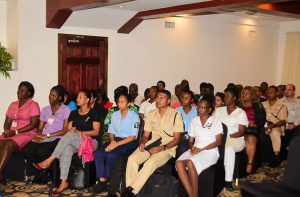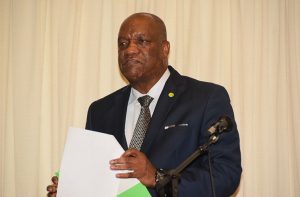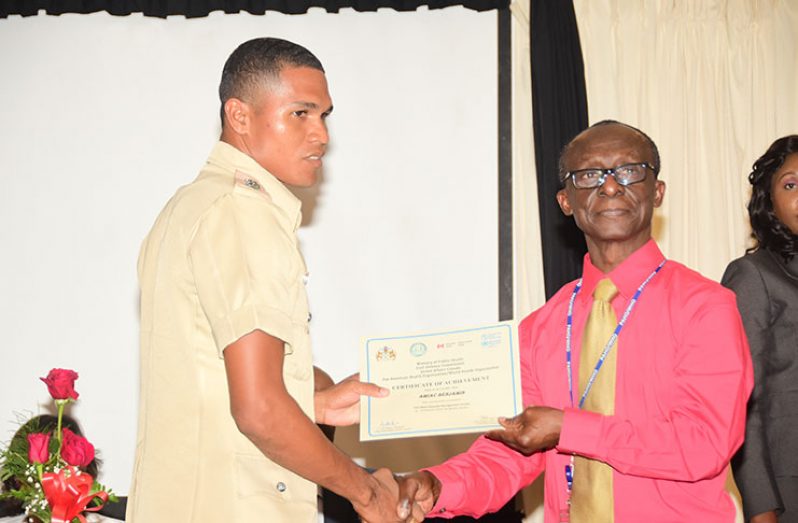GUYANA is now in a better position to respond to any form of disaster now that it is equipped with close to 90 certified Mass Casualty Management System and Incident Command System Officers.
Drawn from approximately 15 organisations across the country, including the Civil Defence Commission (CDC), Public Health Ministry, Guyana Police Force, Guyana Fire Service, Georgetown Public Hospital Corporation (GPHC), Guyana Defence Force (GDF), St. John’s Ambulance Brigade and the Red Cross Society, the participants were on Thursday presented with internationally recognised certificates during a simple ceremony at the Herdmanston Lodge, following a week of intense training.
The Mass Casualty Management System and Incident Command System Courses were organised and facilitated by the Pan American Health Organisation (PAHO) in collaboration with the Civil Defence Commission (CDC), the Public Health Ministry and the Canadian High Commission.
Minister of State Joseph Harmon, who has responsibility for the CDC and Disaster Risk Management, told those present at the closing ceremony, that Government remains committed to building the country’s resilience to disaster risks. He added that the CDC’s subventions have increased from approximately $4M a year in 2015, to in excess of $90M per year in 2018.
EVERYONE’S BUSINESS

“We have worked and will continue to strive to ensure that we are better prepared and able to deal with the increased risks expected from climate change and manmade hazards,” the state minister said, while stating that Disaster Risk Management is everyone’s business.
In underscoring the importance of planning, Minister Harmon said the Government will ensure that the requisite systems are in place in the event that there is a disaster or mass casualty.
“We must plan for all eventualities. It is only by planning and preparing that we will be in a position where we can respond positively. We have limited resources and if we are to have optimum use of those resources, we have to plan carefully and apply the resources we have in a practical and efficient way,” he said.
Alluding to the Mass Casualty Management System and the Incident Command System Courses, the state minister said they are integral in the preservation of public safety and security during emergencies and disasters, as they facilitate the provision of prompt medical response and victim care, effective and efficient resource mobilisation and management, and strengthened inter-agency coordination during mass casualty incidents.
“The knowledge and skill sets you have attained during these training sessions are valuable assets to a Government and its people,” he told the graduates.
The country currently has in place a Mass Casualty Management System and the 24-Hour National Emergency Monitoring System (NEMS).
AUGURS WELL
PAHO/WHO Representative, Dr. William Adu-krow while acknowledging the Government of Guyana’s commitment and resolve to strengthening the nation’s capacity to deal with mass casualty incidents, said the collaboration and multi-stakeholder approach augurs well for the country.
He noted that the courses will have a direct impact in enhancing the technical capacity of the officers to respond effectively to mass casualty incidents.
“Our training courses are not static and will continue to evolve to meet new development needs. In this context, we welcome feedback from the Government,” Dr. Adu-Krow said while pointing out that in addition to the close to 90 personnel trained, six persons completed the instructors training programme for Mass Casualty Management System.
“This will certainly place us in an advantageous position since these esteemed professionals can now plan, organise and conduct training in all the administrative regions in Guyana. Consequently, I would endeavor to proffer a candid challenge to the instructors, the CDC and the Ministry of Public Health to convene Mass Casualty Management training in all regions.”

However, he noted that limited human, material and transportation resources and even poor communication can prevent a smooth and well-coordinated dispatch of victims of a mass casualty incident to various healthcare facilities.
Dr. Adu-krow explained that responders and/or rescuers may be forced to carry all victims to the only care facility available, which may overwhelm the healthcare system.
The PAHO/WHO Representative said as such it becomes necessary for a policy to be established to address those challenges.
“The PAHO/WHO will work closely with the CDC and the Ministry of Public Health to develop an Incident Command and Mass Casualty Management Policy document,” he assured.
Canadian High Commissioner to Guyana, Lilian Chatterjee, in her remarks said that Canada has been a partner to the Caribbean and Guyana in providing support for disaster response and risk management and will continue to do so.
“I must commend the organisers for arranging this, particularly at a time when we here in the Caribbean are dealing with the effects with climate change. The Caribbean is seen as one of the most exposed regions to natural disasters. Canada remains committed to helping the Caribbean rebuild better and stronger for the future. We are working to improve the capacities of countries in the response to natural disasters and to reduce their impact on the people,” she said.
The facilitator, Peter Burgess, in an interview with Guyana Chronicle said the Incident Command System Course was conducted from February 5-7 with 42 persons undergoing extensive training geared towards command control coordination.
The Mass Casualty Management Programme commenced on February 8 for a period of a week.
“Throughout the course of that training the participants were taught a number of theoretical sessions, as well as a number of educational videos on disasters and different incidents,” Burgess said, while adding that as a multi-sectorial group they were challenged to share their experiences within the different professions.
“That culminated with a desktop exercise as well as a practical exercise in Durban Park last night (Tuesday), and coming out of that participants were taken through a lot of disaster type scenarios where they had to treat victims and transport them to hospitals,’ the facilitator further explained. Some 39 persons undertook the Mass Casualty Course.
That course recorded an 85 per cent pass rate while the Incident Command System Courses recorded an 80 per cent success rate. The certified officers will be deployed during the Mashramani celebrations.




.png)









